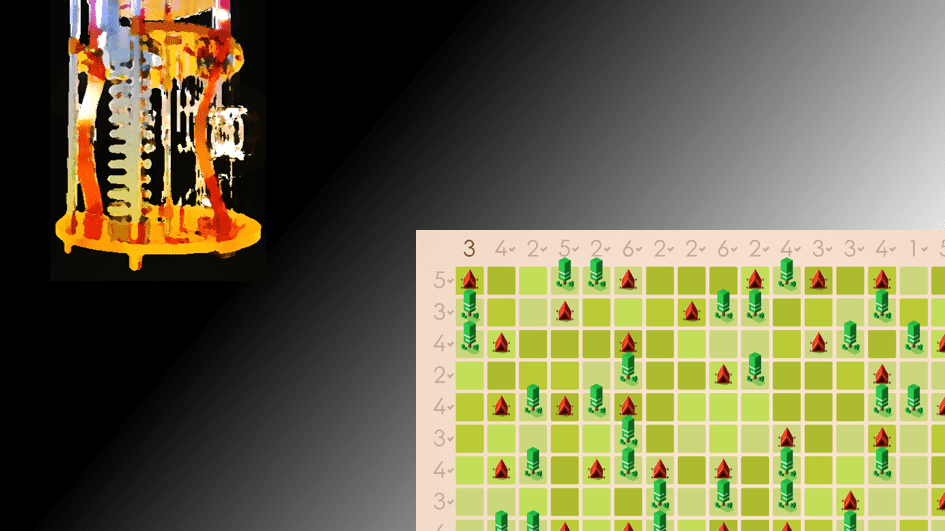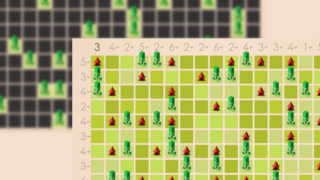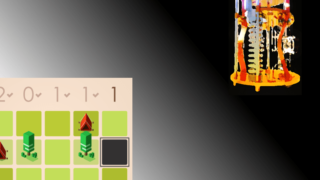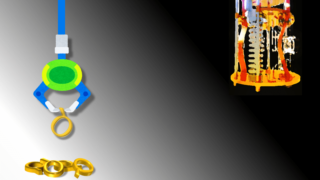やること
20-2はGAでテント・アンド・ツリーの大規模な問題を解きました。
21-2はD-waveで同じく小規模な問題を解きました。
21-3ではD-waveで大規模な問題を解く準備を行いました。
さっそくD-waveで大規模なテント・アンド・ツリーに挑戦してみましょう!
実行環境
WinPython3.6をおすすめしています。
WinPython - Browse /WinPython_3.6/3.6.7.0 at SourceForge.net
Portable Scientific Python 2/3 32/64bit Distribution for Windows
パズル問題
必要なパッケージをimportします。
import numpy as np
from scipy import signal
from dwave.system.composites import EmbeddingComposite
from dwave.system.samplers import DWaveSampler
from pyqubo import Binary
from dwave_qbsolv import QBSolvパズル問題は、まずは21-2と同じ5*5サイズのものを記述します。
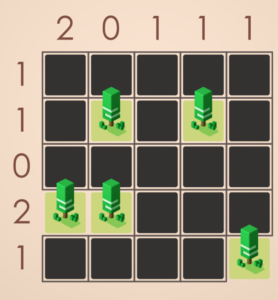
#============================
# パズル
#============================
pazzle = ['-----',
'-t-t-',
'-----',
'tt---',
'----t']
horizontal = [2,0,1,1,1]
vertical = [1,1,0,2,1]
#============================
# パズルの変換とフィルタの用意
#============================
tree = []
for line in pazzle:
line = line.replace('-', '0')
line = line.replace('t', '1')
tree.append(list(line))
tree = np.array(tree, dtype=int)
print('tree\n{}'.format(tree))
tent = np.zeros(tree.shape, dtype=int)
print('tent\n{}'.format(tent))
horizontal = np.array(horizontal)
print('horizontal\n{}'.format(horizontal))
vertical = np.array(vertical)
print('vertical\n{}'.format(vertical))
#畳み込み用のフィルタ
filter_4 = np.array([[0, 1, 0],
[1, 0, 1],
[0, 1, 0]], dtype=int)
filter_8 = np.array([[1, 1, 1],
[1, 0, 1],
[1, 1, 1]], dtype=int)tree
[[0 0 0 0 0]
[0 1 0 1 0]
[0 0 0 0 0]
[1 1 0 0 0]
[0 0 0 0 1]]
tent
[[0 0 0 0 0]
[0 0 0 0 0]
[0 0 0 0 0]
[0 0 0 0 0]
[0 0 0 0 0]]
horizontal
[2 0 1 1 1]
vertical
[1 1 0 2 1]量子ビットの用意
詳しい説明は割愛します。
#============================
# 量子ビットの用意
#============================
#木の4近傍のマス(=テント候補地)
mask_candidate = (signal.convolve2d(tree, filter_4, mode='same') > 0) * (tree == 0)
print('mask_candidate\n{}'.format(mask_candidate))
#量子ビットの数
num_qbits = np.sum(mask_candidate)
print('num_qbits\n{}'.format(num_qbits))
#テント候補地にインデックスを振る(テント候補地以外は-1)
candidate_index = np.ones(tree.shape, dtype=int) * -1
candidate_index[mask_candidate==True] = range(num_qbits)
print('candidate_index\n{}'.format(candidate_index))
#量子ビットを用意する
for i in range(num_qbits):
command = 'q{:03} = Binary(\'q{:03}\')'.format(i, i)
print(command)
exec(command)mask_candidate
[[False True False True False]
[ True False True False True]
[ True True False True False]
[False False True False True]
[ True True False True False]]
num_qbits
13
candidate_index
[[-1 0 -1 1 -1]
[ 2 -1 3 -1 4]
[ 5 6 -1 7 -1]
[-1 -1 8 -1 9]
[10 11 -1 12 -1]]
q000 = Binary('q000')
q001 = Binary('q001')
q002 = Binary('q002')
q003 = Binary('q003')
q004 = Binary('q004')
q005 = Binary('q005')
q006 = Binary('q006')
q007 = Binary('q007')
q008 = Binary('q008')
q009 = Binary('q009')
q010 = Binary('q010')
q011 = Binary('q011')
q012 = Binary('q012')自動的に量子ビットが13個定義されました。
条件1|各木の4近傍のマスは1つか2つだけ1になる
面倒くさくてコードはあまり洗練していませんが、条件が自動的に設定されます。
#============================
# 条件を記述する
#============================
#条件を記述する関数
def H_add(qbits, num):
command = '(' + '+'.join(['q{:03}'.format(i) for i in qbits]) + '-{})**2'.format(num)
print(command)
return eval(command)
#条件を記述していく
H = 0
#条件1、各木の4近傍のマスについて、1つか2つだけ1になる
#各木について
for i, j in np.array(np.where(tree==1)).T:
#注目する木の座標
print(i, j)
#一つの木
mask_single_tree = np.zeros(tree.shape, dtype=int)
mask_single_tree[i, j] = 1
#その周囲のテント候補地
mask_around_single_tree = signal.convolve2d(mask_single_tree, filter_4, mode='same') * mask_candidate
#print('mask_around_single_tree\n{}'.format(mask_around_single_tree))
#そのインデックス
qbits_index = candidate_index[mask_around_single_tree>0]
#print('qbits_index\n{}'.format(qbits_index))
#これらは1つか2つだけ1になる
H += H_add(qbits_index, 1.5)1 1
(q000+q002+q003+q006-1.5)**2
1 3
(q001+q003+q004+q007-1.5)**2
3 0
(q005+q010-1.5)**2
3 1
(q006+q008+q011-1.5)**2
4 4
(q009+q012-1.5)**2条件2|8近傍で隣接する2つのマスは0つまたは1つだけ1になる
#条件2、8近傍で隣接する2つのマスのうち、0つまたは1つだけ1になる
#各テント候補地について
for i, j in np.array(np.where(mask_candidate==1)).T:
#他のテント候補地が
for k, l in np.array(np.where(mask_candidate==1)).T:
#8近傍の関係であれば
if (k, l) == (i, j+1) or (k, l) == (i+1, j-1) or (k, l) == (i+1, j) or (k, l) == (i+1, j+1):
#注目する2つのテント候補地
print((i, j), (k, l))
#これらのインデックス
qbits_index = [candidate_index[i, j], candidate_index[k, l]]
#print(qbits_index)
#これらは0つまたは1つだけ1になる
H += H_add(qbits_index, 0.5)(0, 1) (1, 0)
(q000+q002-0.5)**2
(0, 1) (1, 2)
(q000+q003-0.5)**2
(0, 3) (1, 2)
(q001+q003-0.5)**2
(0, 3) (1, 4)
(q001+q004-0.5)**2
(1, 0) (2, 0)
(q002+q005-0.5)**2
(1, 0) (2, 1)
(q002+q006-0.5)**2
(1, 2) (2, 1)
(q003+q006-0.5)**2
(1, 2) (2, 3)
(q003+q007-0.5)**2
(1, 4) (2, 3)
(q004+q007-0.5)**2
(2, 0) (2, 1)
(q005+q006-0.5)**2
(2, 1) (3, 2)
(q006+q008-0.5)**2
(2, 3) (3, 2)
(q007+q008-0.5)**2
(2, 3) (3, 4)
(q007+q009-0.5)**2
(3, 2) (4, 1)
(q008+q011-0.5)**2
(3, 2) (4, 3)
(q008+q012-0.5)**2
(3, 4) (4, 3)
(q009+q012-0.5)**2
(4, 0) (4, 1)
(q010+q011-0.5)**217個設定されました。
条件3|各行、各列の “テントの数” と “数字” が一致する
#条件3、各行、各列の "テントの数" と "数字" が一致する
#vertical
for i in range(len(vertical)):
#この列のインデックス
qbits_index = candidate_index[i, :][candidate_index[i, :] > -1]
print(qbits_index)
#これらは指定された数だけ1になる
H += H_add(qbits_index, vertical[i])
#horizontal
for i in range(len(horizontal)):
#この列のインデックス
qbits_index = candidate_index[:, i][candidate_index[:, i] > -1]
print(qbits_index)
#これらは指定された数だけ1になる
H += H_add(qbits_index, horizontal[i])[0 1]
(q000+q001-1)**2
[2 3 4]
(q002+q003+q004-1)**2
[5 6 7]
(q005+q006+q007-0)**2
[8 9]
(q008+q009-2)**2
[10 11 12]
(q010+q011+q012-1)**2
[ 2 5 10]
(q002+q005+q010-2)**2
[ 0 6 11]
(q000+q006+q011-0)**2
[3 8]
(q003+q008-1)**2
[ 1 7 12]
(q001+q007+q012-1)**2
[4 9]
(q004+q009-1)**25*5サイズの問題で動作を確認してみる
最後のパーツを追加して実行します。
#コンパイル
model = H.compile()
qubo, offset = model.to_qubo()
print('qubo\n{}'.format(qubo))
#D-waveの設定
sampler = EmbeddingComposite(DWaveSampler(endpoint='https://cloud.dwavesys.com/sapi',
token='your_token',
solver='DW_2000Q_5'))
#問題を分割してサンプリングしまくる
response = QBSolv().sample_qubo(qubo, solver=sampler, num_repeats=50)
#レスポンスの確認
count = 0
print('response')
for (sample, energy, occurrences) in response.data():
print('Sample:{} Energy:{} Occurrences:{}'.format(list(sample.values()), energy, occurrences))
#1番目を保存しておく
if count == 0:
best_sample = np.array(list(sample.values()))
count += 1
if count > 20:
break
#最頻解の確認
print('best_sample\n{}'.format(best_sample))
#============================
# テントの位置を確認
#============================
tent[mask_candidate] = best_sample
print('tent\n{}'.format(tent))response
Sample:[0, 1, 1, 0, 0, 0, 0, 0, 1, 1, 1, 0, 0] Energy:-24.0 Occurrences:48
Sample:[1, 0, 0, 0, 1, 0, 0, 0, 1, 1, 1, 0, 0] Energy:-20.0 Occurrences:2
Sample:[1, 1, 0, 0, 0, 0, 0, 0, 1, 1, 1, 0, 0] Energy:-20.0 Occurrences:1
Sample:[0, 0, 0, 1, 0, 0, 0, 0, 1, 1, 1, 0, 0] Energy:-20.0 Occurrences:3
best_sample
[0 1 1 0 0 0 0 0 1 1 1 0 0]
tent
[[0 0 0 1 0]
[1 0 0 0 0]
[0 0 0 0 0]
[0 0 1 0 1]
[1 0 0 0 0]]21-2と同じ結果になりました。きちんと動作しています。
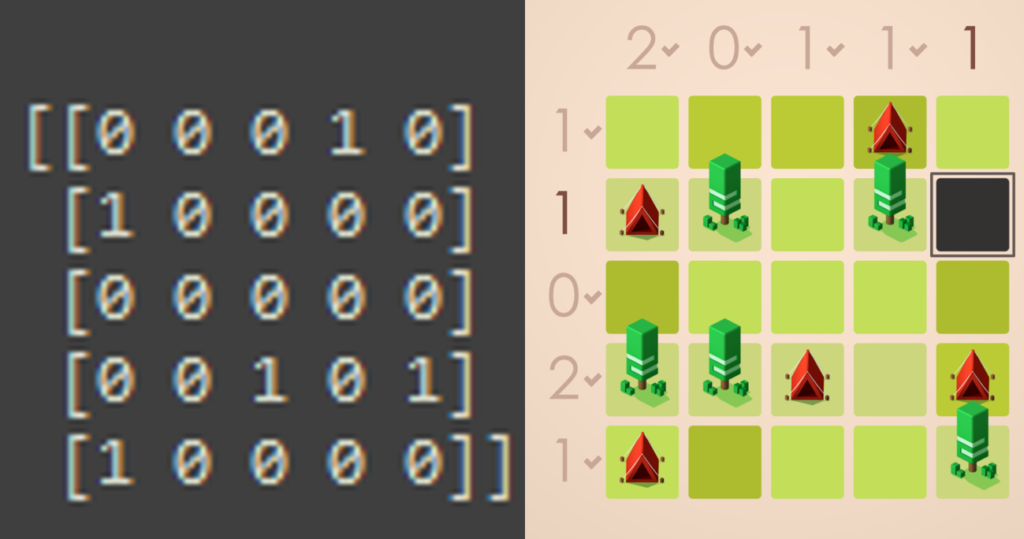
18*18サイズの問題
ここからが本番です。問題を書き換えるだけで、すべて自動的にやってくれます(感無量)。
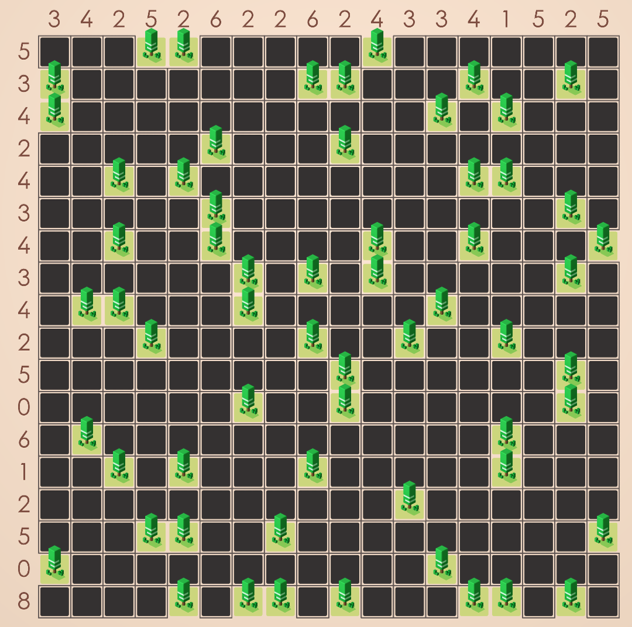
#============================
# パズル
#============================
pazzle = ['---tt-----t-------',
't-------tt---t--t-',
't-----------t-t---',
'-----t---t--------',
'--t-t--------tt---',
'-----t----------t-',
'--t--t----t--t---t',
'------t-t-t-----t-',
'-tt---t-----t-----',
'---t----t--t--t---',
'---------t------t-',
'------t--t------t-',
'-t------------t---',
'--t-t---t-----t---',
'-----------t------',
'---tt--t---------t',
't-----------t-----',
'----t-tt-t---tt-t-']
horizontal = [3,4,2,5,2,6,2,2,6,2,4,3,3,4,1,5,2,5]
vertical = [5,3,4,2,4,3,4,3,4,2,5,0,6,1,2,5,0,8]...
best_sample
[1 0 1 0 1 1 1 0 0 1 0 1 0 0 0 0 1 1 1 0 0 1 0 1 0 0 0 0 0 1 0 0 1 0 1 1 1
0 0 1 0 0 0 0 1 1 0 0 1 1 0 1 1 1 0 0 0 0 0 0 0 0 0 0 0 1 0 1 1 0 1 1 0 1
1 0 0 0 0 1 0 0 0 0 0 0 0 0 1 0 1 1 1 0 1 0 0 1 0 0 0 0 0 0 0 0 1 1 1 0 0
1 1 0 1 0 0 0 1 0 0 0 0 0 0 0 0 0 1 0 1 0 0 1 1 0 1 0 1 1 0 0 0 0 0 0 0 0
0 0 0 1 1 1 1 1 1 1 1]
tent
[[1 0 0 0 0 1 0 0 0 1 0 1 0 1 0 0 0 0]
[0 0 0 1 0 0 0 1 0 0 0 0 0 0 0 0 0 1]
[0 1 0 0 0 1 0 0 0 0 0 1 0 0 0 1 0 0]
[0 0 0 0 0 0 0 0 1 0 0 0 0 1 0 0 0 0]
[0 1 0 1 0 1 0 0 0 0 0 0 0 0 0 1 0 0]
[0 0 0 0 0 0 0 0 0 0 1 0 0 1 0 0 0 1]
[0 1 0 0 1 0 1 0 1 0 0 0 0 0 0 0 0 0]
[0 0 0 0 0 0 0 0 0 0 0 0 1 0 0 1 0 1]
[0 0 0 1 0 1 0 0 1 0 1 0 0 0 0 0 0 0]
[0 1 0 0 0 0 0 0 0 0 0 0 0 0 0 1 0 0]
[0 0 0 1 0 0 1 0 1 0 0 1 0 0 0 0 0 1]
[0 0 0 0 0 0 0 0 0 0 0 0 0 0 0 0 0 0]
[1 0 1 0 1 0 0 0 0 1 0 0 0 1 0 0 1 0]
[0 0 0 0 0 0 0 1 0 0 0 0 0 0 0 0 0 0]
[0 0 0 0 0 0 0 0 0 0 1 0 0 0 1 0 0 0]
[0 0 1 0 0 1 0 0 1 0 0 0 1 0 0 0 1 0]
[0 0 0 0 0 0 0 0 0 0 0 0 0 0 0 0 0 0]
[1 0 0 1 0 1 0 0 1 0 1 0 1 0 0 1 0 1]]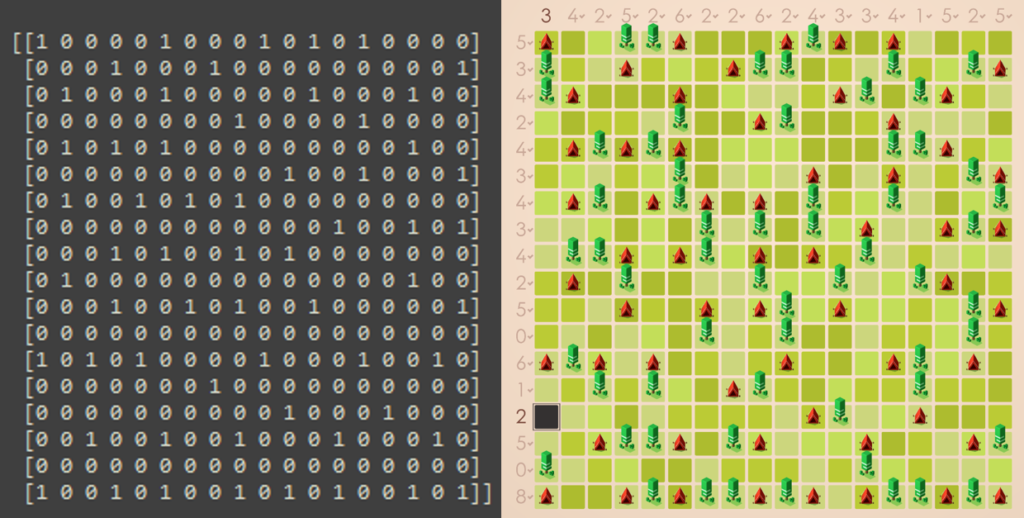
解けました!

